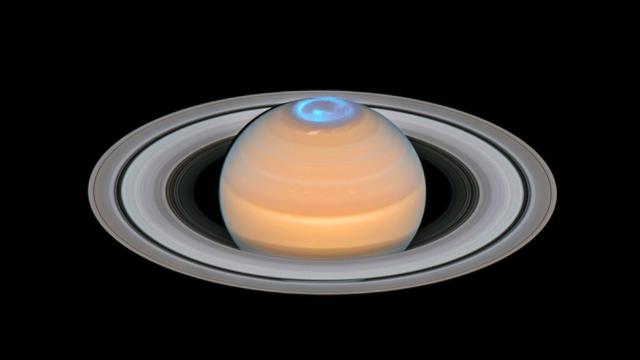Sometimes, things line up just perfectly. For example, back in 2017, the Hubble Space Telescope got a full view of Saturn’s northern aurora. The newly-released image above isn’t exactly what Hubble saw — but it’s still exciting, I promise.
This observation aligned with the Cassini mission’s grand finale. Working in tandem, Cassini and Hubble were able to take the best view of Saturn’s aurora yet, and make some brand new discoveries about it.
While the aurora looks blue in this picture, it’s actually ultraviolet light. This image is a composite of an early 2018 observation with the ultraviolet auroral data, taken in May 2017, translated into colours that our eyes can see and plopped on top.
Saturn’s poles emit this light when hydrogen gas interacts with high-powered electrons generated in its magnetic field. Its auroras are intense and ever-changing, thanks to its powerful magnetosphere and rapid rotation. Saturn’s days are only 11-hours long.
On Earth’s May 24, the planet achieved its summer solsice, when its northern pole tilted towards the Sun, as happens on our own planet’s Northern Hemisphere summer solstice. Scientists used Hubble to image Saturn’s ultraviolet aurora while Cassini took some of its final measurements.
The combined observations revealed that auroral activity peaked around dawn, Saturn time, something that Cassini scientists observed before. But they also revealed another, never-before-seen strong peak in activity a little before Saturnian midnight.
This newly-observed spike in auroral activity was “strikingly reminiscent of Earth’s aurora,” according to the paper published in Geophysical Research Letters. The scientists inferred that it was likely caused by the solar wind.
These Hubble images provide important context for the Cassini data taken at the same time. Just before its final plunge into the gas giant in September, Cassini captured data on a never-before-seen feature of Saturn’s aurora, for example.
Saturn, like Earth, is a spinning spheroid with a magnetic field. It has auroras just like we do — but there’s still much to learn about how its auroras work.
[GRL, GRL via HubbleSite]
